02/12/2024
11 min read

After winning Super Bowl LVII in 2023, the Kansas City Chiefs entered Super Bowl LVIII with an opportunity to pull off back-to-back wins, a feat last achieved by the New England Patriots two decades earlier, in 2003 and 2004. They faced the San Francisco 49ers, five-time Super Bowl champions, although their last win was nearly three decades ago, in 1995. The game started slowly, remaining scoreless until the start of the second quarter, after which both teams traded the lead until a tie score at the end of the game made it only the second Super Bowl to go into overtime. And if you weren’t watching it for the football, the advertisements certainly didn’t disappoint. And if you weren’t watching it for the football or the advertisements, but instead were waiting to see how many times CBS cut away to a shot of Taylor Swift during the game, the answer is… 16. (By my count, at least.)
In this blog post, we will explore which Super Bowl advertisements drove the largest spikes in traffic, as well as examine how traffic to food delivery services, social media, sports betting, and video platform websites and applications changed during the game. In addition, we look at local traffic trends seen during the game, as well as email threat volume across related categories in the weeks ahead of the game.
Cloudflare Radar uses a variety of sources to provide aggregate information about Internet traffic and attack trends. In this blog post, as we did last year and the year before, we use DNS name resolution data from our 1.1.1.1 resolver to estimate traffic to websites. We can’t see who visited the websites mentioned, or what anyone did on the websites, but DNS can give us an estimate of the interest generated by the ads or across a set of sites in the categories listed above.
Ads: URLs are no longer cool
In last year’s blog post, we asked “Are URLs no longer cool?”, noting that many of the advertisements shown during Super Bowl LVII didn’t include a URL. The trend continued into 2024, as over 100 ads were shown throughout Super Bowl LVIII, but only about one-third of them contained URLs — some were displayed prominently, some were in very small type. A few of the advertisements contained QR codes, and a few suggested downloading an app from Apple or Google’s app stores, but neither approach appears to be a definitive replacement for including a link to a website in the ad. And although Artificial Intelligence (AI) has all but replaced cryptocurrency as the thing that everyone is talking about, the lone AI ad during this year’s game was for Microsoft Copilot, which the company is positioning as an “everyday AI companion”.
As we did last year, we again tracked DNS request traffic to our 1.1.1.1 resolver in United States data centers for domains associated with the advertised products or brands. Traffic growth is plotted against a baseline calculated as the mean request volume for the associated domains between 12:00-15:00 EST on Sunday, February 11 (Super Bowl Sunday). The brands highlighted below were chosen because their advertisements drove some of the largest percentage traffic spikes observed during the game.
TurboTax
Although most Americans dislike having to pay taxes, they apparently feel that winning a million dollars would make doing so a little less painful. The Intuit TurboTax Super Bowl File ad, starring Emmy Award winner Quinta Brunson, included a URL pointing visitors to turbotax.com, where they could register to win one million dollars. The promotion aired a couple of times before the game began, visible as small spikes in the graph below, but it paid off for Intuit when it was shown at 19:56, driving traffic 24,875% above baseline and placing it as the ad that drove the largest increase in traffic.
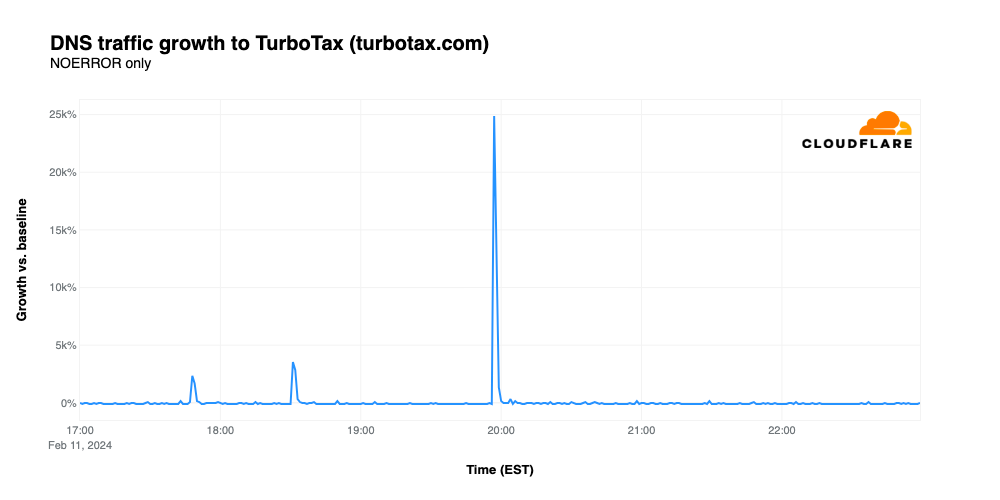
DoorDash
Most DoorDash deliveries are fairly nominal, and should be able to easily fit in the Dasher’s car. However, in a twist, the delivery for the “DoorDash all the ads” promotion includes several cars, as well as candy, cosmetics, trips, mayonnaise, and a myriad of other items, all of which appeared in Super Bowl advertisements, as a way for the company to demonstrate that they deliver more than. The ad, which prominently featured a URL for the contest site, aired at 22:03 EST and drove traffic 24,574% above baseline. The graph below shows that prominent spike, but it also shows traffic remaining 1700-2500% above baseline after the ad aired. This elevated traffic is likely due to efforts to transcribe the full promo code needed to enter the contest. The promo code, as crowdsourced in a Reddit thread, clocks in at a whopping 1,813 characters.
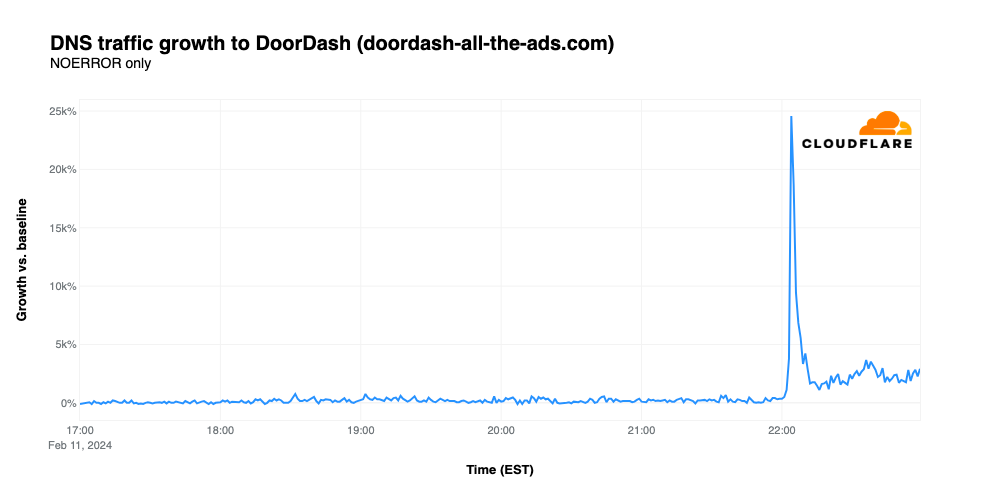
Poppi
Super Bowl ads for “new” drink brands have frequently driven significant amounts of traffic, such as the growth seen by Cutwater Spirits in 2022. Relative newcomer Poppi, a brand of soda that contains prebiotics, continued the trend, with traffic spiking 7,329% above baseline after its ad appeared at 20:04 EST, despite no URL appearing in the advertisement. However, it appears that not everyone was a fan of the ad, as critics complained that it “food shamed” those who choose to drink traditional sodas.
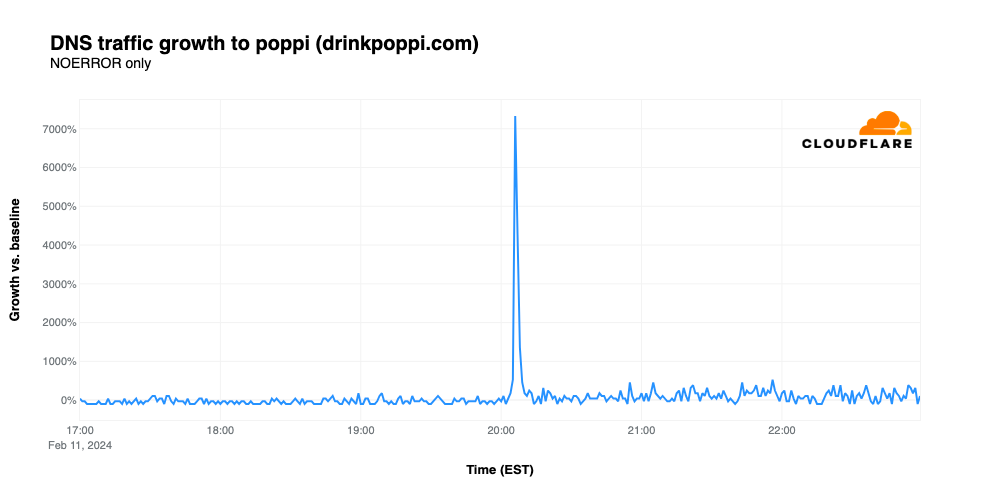
e.l.f. Cosmetics
The cosmetic brand’s second Super Bowl advertisement featured Judge Judy presiding over a courtroom scene featuring musician Meghan Trainor and the cast of the USA Network legal drama Suits. While the ad drove traffic for elfcosmetics.com to 8,118% over baseline despite lacking a URL, the timing of the growth is unusual as it doesn’t align with the time the ad aired (20:22 EST). The traffic starts to tick up around 21:24 EST, just after a Chiefs touchdown put them in the lead, peaking at 22:53, several minutes after the Chiefs won the game. It isn’t clear why e.l.f. appears to buck the trend seen for most Super Bowl ads, showing a gradual ramp in traffic before peaking, as opposed to a large spike aligned with the time that the ad was broadcast.
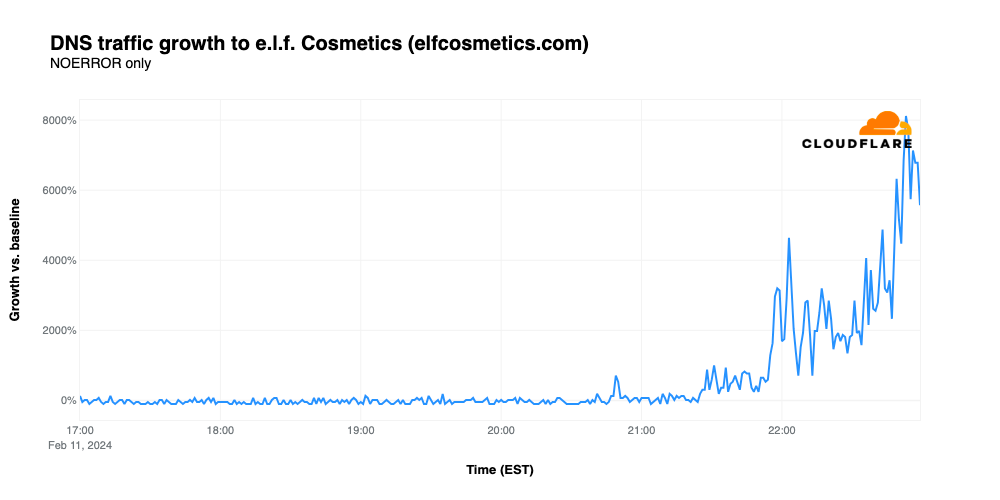
In addition to the advertisements discussed above, a number of others also experienced traffic spikes greater than 1,000% above baseline, including ads for the NFL, Hallow, He Gets Us, homes.com, Kawasaki, Robert F. Kennedy, Jr. 2024, Snapchat, Skechers, and Volkswagen.
App traffic sees mixed impacts
Using the same baseline calculations described above, we also looked at traffic for domains associated with several groups of sites, including food delivery, messaging, social media, and sports betting to see how events that occurred during the game impacted traffic. Traffic shifts among most of these groups remained fairly nominal during the game, with sports betting seeing the largest movement. Halftime is clearly visible within the graphs, as viewers apparently focused on the musical performance, which featured R&B singer Usher, joined by guests Alicia Keys, H.E.R., will.i.am, Ludacris, and Lil Jon.
Food delivery
Traffic for food delivery sites remained relatively constant, on average, through the first quarter of the game, and started to decline as the second quarter started. A more significant dip is visible during halftime, with the drop continuing through the end of overtime. The outlier, of course, is the spike that occurred when the DoorDash advertisement aired, even though it featured a domain other than doordash.com, which is a member of this group.
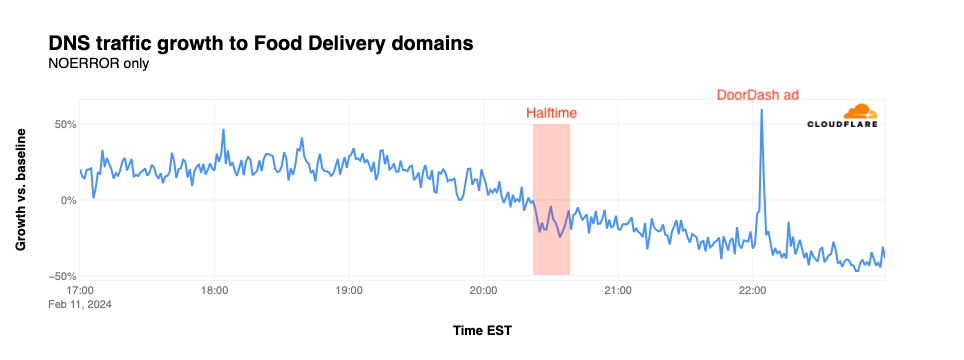
Messaging
Traffic to domains associated with messaging applications generally remained just below baseline throughout the first half of the game. The spikes above baseline during the first half were nominal, and don’t appear to be associated with any notable in-game events. Traffic picked back up briefly as the halftime show ended, jumping to 14% above baseline. After that, traffic continued to drop until 22:46 EST, when the Chiefs sealed their victory with an overtime touchdown, causing traffic for messaging sites to spike to 34% above baseline.
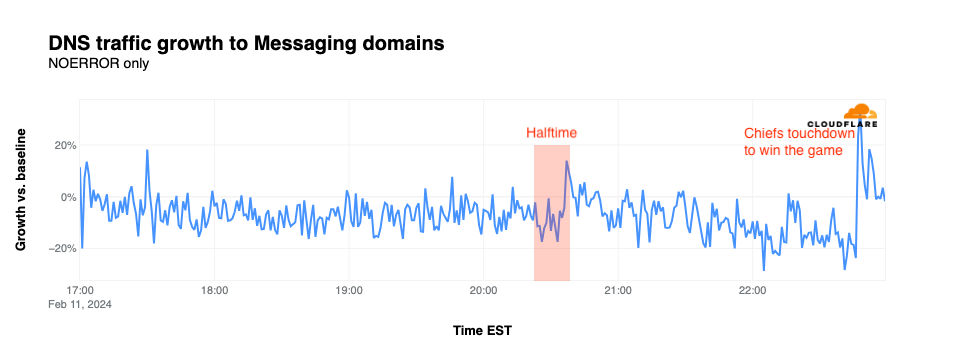
Traffic for social media sites often spikes in conjunction with major plays, such as fumbles or touchdowns, as fans take to their favorite sites and apps to share photos or videos, or to celebrate or vent, depending on the team they support. Although social media traffic was fairly flat ahead of the start of the game, it began to see some spikiness as Post Malone sang America the Beautiful. This nominal spikiness continued through halftime, although none of the peaks were clearly correlated with major plays during the first half. Similar to messaging, a notable drop in traffic occurred during halftime followed by a spike as Usher’s halftime show ended. In the second half, traffic spiked as the Chiefs tied the game with a field goal, for the overtime coin toss, and as the 49ers took the lead with an overtime field goal. Interestingly, that final spike visible in the graph occurs approximately six minutes after the Chiefs’ game-winning touchdown during an ad break ahead of the post-game show.
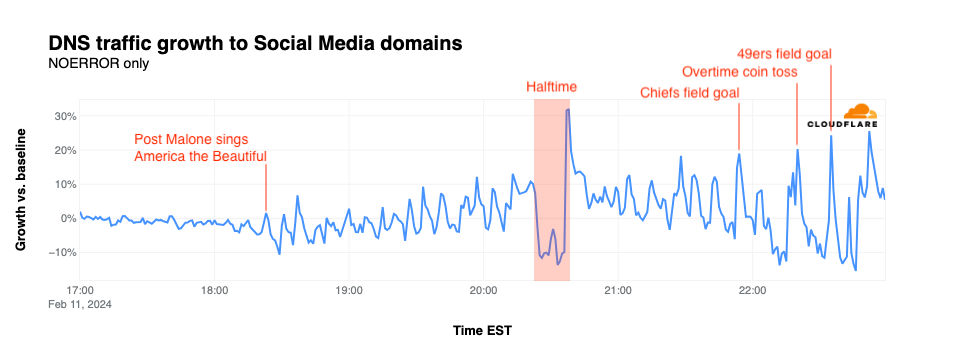
Sports betting
Compared to the relatively anemic traffic growth (when it was actually above baseline) seen for the categories above, traffic for domains associated with sports betting sites and apps remained significantly above baseline throughout the game with the exception of the dip during halftime, similar to what was also seen in the categories above. The first spike occurred just minutes before the coin toss, jumping to 412% above baseline. The game’s first touchdown, scored by the 49ers, caused traffic to spike 705% above baseline. A 413% spike occurred when the Chiefs took the lead late in the third quarter, with a slightly smaller one occurring at the end of regulation play as the game entered overtime. The final spike occurred just a couple of minutes after the Chiefs scored the game-winning touchdown, reaching 548% above baseline.
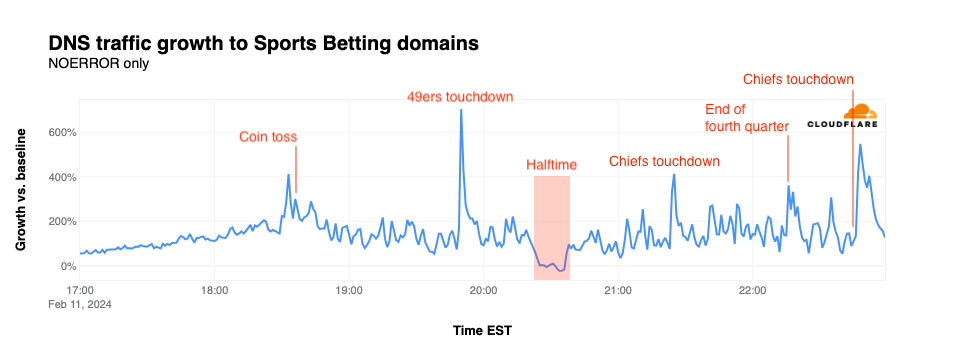
Zooming in to Kansas City and San Francisco
Using the same baseline calculations highlighted in the previous two sections, we also looked at changes in DNS traffic for the domains associated with the Kansas City Chiefs (chiefs.com) and the San Francisco 49ers (49ers.com). In addition, we looked at HTTP traffic from these two cities, using traffic levels from one week prior as a baseline.
By and large, DNS traffic for chiefs.com did not appear to be significantly impacted by most of the team’s field goals or touchdowns during the game, as seen in the graph below. The exception is the traffic spike seen as the team tied the game towards the end of the fourth quarter, forcing the game into overtime. That play resulted in a spike of traffic for the team’s website that reached 1,887% above baseline. Traffic spiked again after the Chiefs won the game, spiking to 1,360% above baseline.
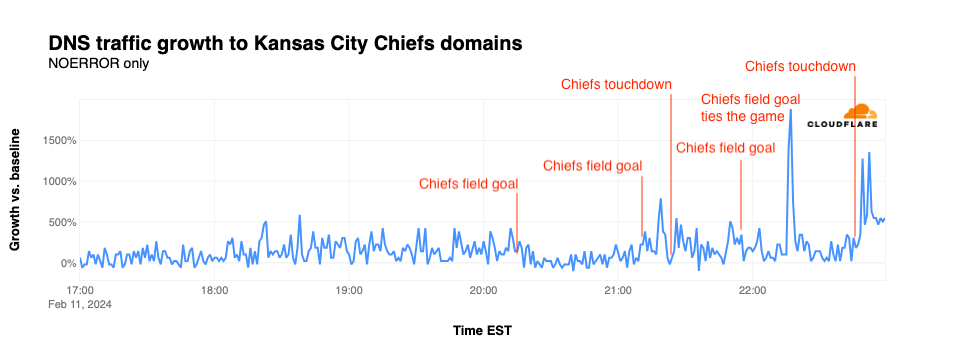
DNS traffic for 49ers.com did not exhibit significant shifts correlated with field goals or touchdowns. The most significant spike reached 1,023% over baseline at the end of the third quarter, minutes after the team called for a timeout.
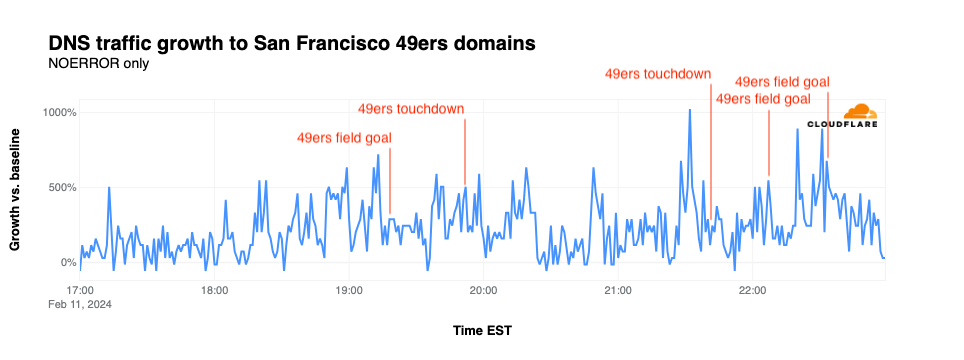
When comparing traffic trends for Kansas City and San Francisco, they could hardly be more different. Looking at request traffic from Kansas City, we find that it remains below traffic seen during the same time frame on February 4, with notable drops at the start of the game, during halftime, and when the Chiefs tied the game with a field goal late in the fourth quarter. Traffic hit its lowest point when the Chiefs won the game, but then recovered to meet/exceed the prior week’s traffic levels once the broadcast had concluded.
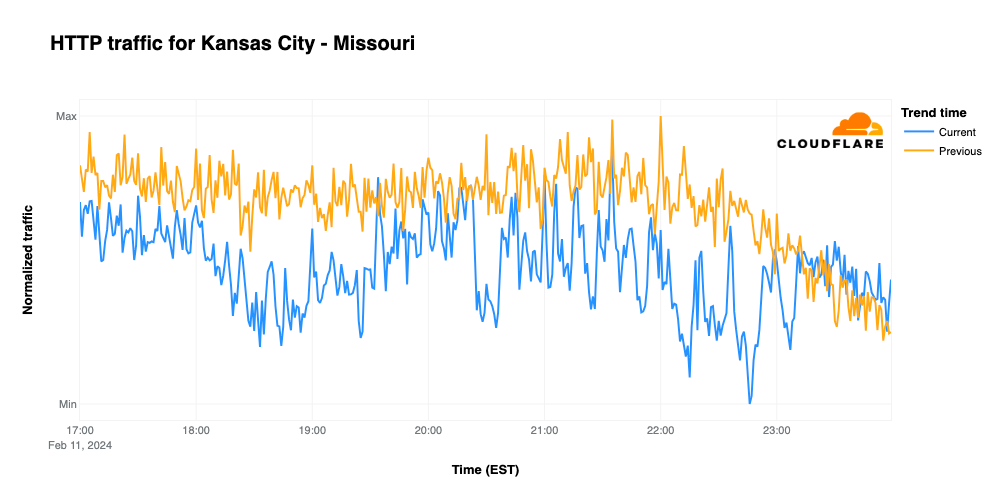
In contrast, traffic from San Francisco remained well below traffic levels seen the previous Sunday before unexpectedly spiking around 19:30 EST. Request traffic then remained well above the previous week’s levels until San Francisco kicked a field goal to take the initial lead during overtime play. Traffic remained roughly in line with the previous week until the broadcast ended, and then remained slightly higher.
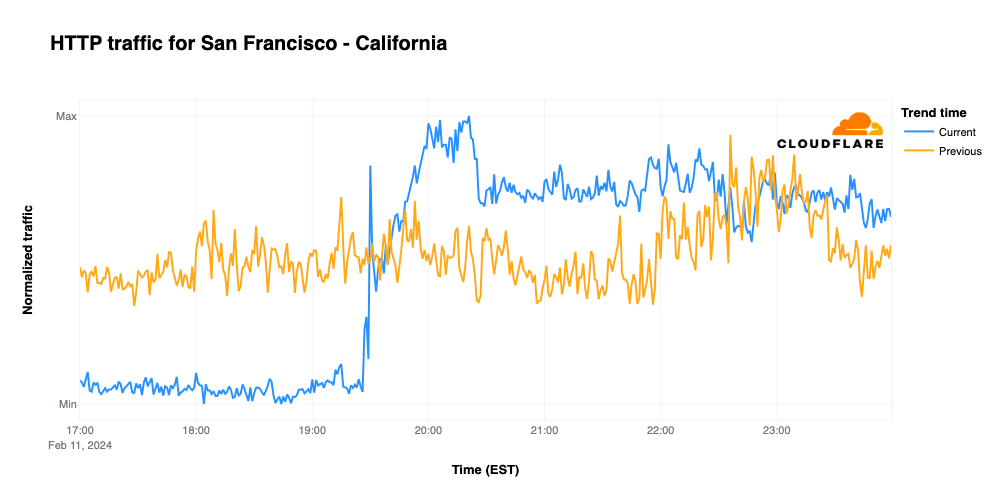
Email threats and “The Big Game”
As we noted in last year’s blog post, spammers and scammers will frequently try to take advantage of the popularity of major events when running their campaigns, hoping the tie-in will entice the user to open the message and click on a malicious link, or visit a malicious website where they give up a password or credit card number. The Cloudflare Area 1 Email Security team once again analyzed the subject lines of email messages processed by the service in the weeks leading up to the Super Bowl to identify malicious, suspicious, and spam messages across four topic areas: Super Bowl/football, sports media/websites, sports gambling, and food delivery.
Super Bowl/Football
Spammers and scammers apparently didn’t feel that the “Super Wild Card Weekend” nor the divisional playoffs were sufficiently interesting to use as bait for their campaigns, as the volume of Super Bowl and football themed unwanted and potentially malicious email messages throughout January remained relatively low and fairly consistent. However, they apparently knew that the big game itself would draw interest, as the volume of such messages increased more than 6x over the prior week in the days ahead of the game.
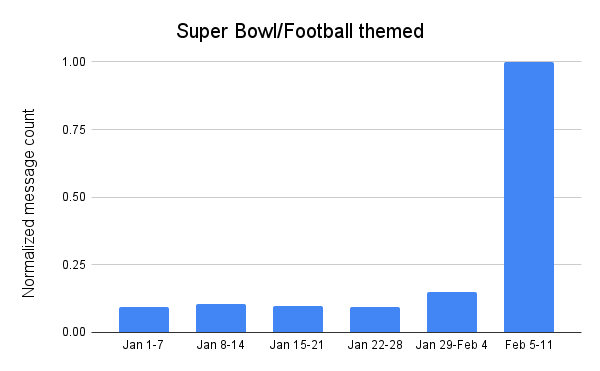
Sports media/websites
Attackers appeared to lose interest in using messages with subject lines related to sports media and websites as January progressed, with the volume of related messages peaking the first week of the month. However, similar to Super Bowl and football themed messages, this theme took on renewed interest in the week leading up to the Super Bowl, with message volume reaching over 3x the previous week, and 1.8x the peak seen durinthe first week of the year.
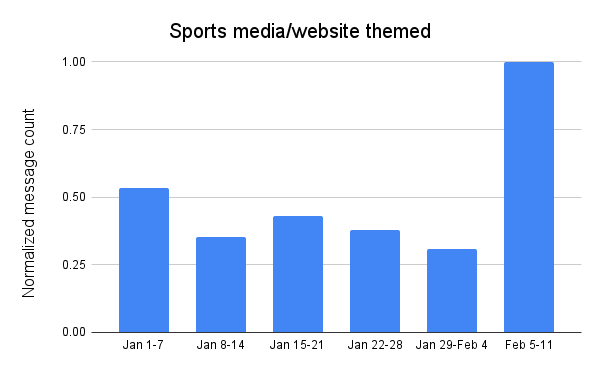
Sports gambling
The final weekend of regular season games (on January 6 & 7) again drove the highest volume of sports gambling themed messages, similar to the pattern seen in 2023. Message volume dropped by about a third over the next two weeks, but picked back up around the divisional and conference playoff games and into the Super Bowl. Even with the growth into the Super Bowl, gambling-themed spam and malicious message volume remained 10% lower than the peak seen a month earlier.
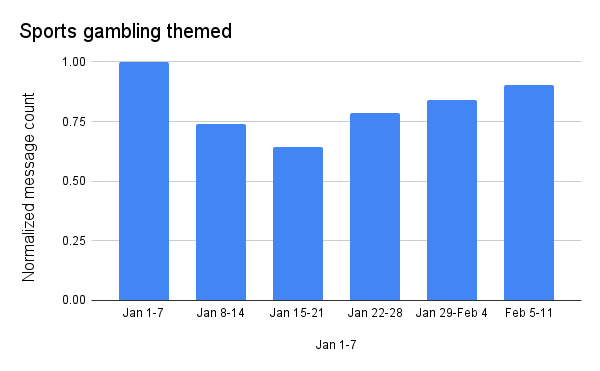
Food delivery
Peak volume of food delivery themed messages was an order of magnitude (10x) higher than the Super Bowl and football themed peak, which was the next largest. Due to the popularity of such services, it appears that it is a regular theme for spam and potentially malicious messages, as volume remained extremely high throughout January. After peaking the week of January 8-14, message volume was lower each of the following weeks, reaching its nadir in the week leading up to the Super Bowl, 47% lower than the peak volume.
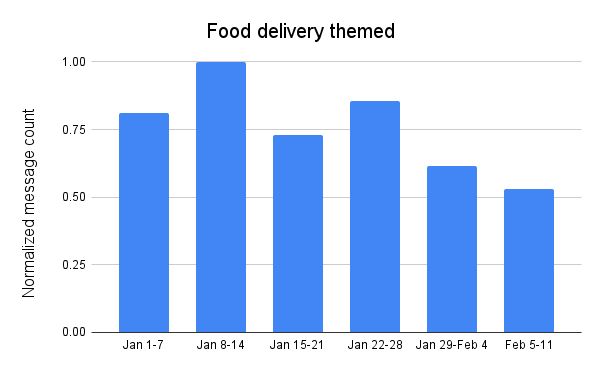
Conclusion
Likely peaking during the so-called “dot.com” Super Bowls nearly a quarter-century ago, most Super Bowl ads no longer drive traffic to associated websites by including a URL in their ad. However, as our DNS traffic analysis found, it appears that viewers don’t seem to have much trouble finding these sites. We also found that in-game events had a mixed impact on traffic across domains associated with multiple types of apps, as well as traffic for the websites associated with the teams playing in the Super Bowl.
For more insights into Internet trends, we encourage you to visit Cloudflare Radar. You can contact the Cloudflare Radar team at [email protected] or on social media at @CloudflareRadar (X/Twitter), cloudflare.social/@radar (Mastodon), and radar.cloudflare.com (Bluesky).
We protect entire corporate networks, help customers build Internet-scale applications efficiently, accelerate any website or Internet application, ward off DDoS attacks, keep hackers at bay, and can help you on your journey to Zero Trust.
Visit 1.1.1.1 from any device to get started with our free app that makes your Internet faster and safer.
To learn more about our mission to help build a better Internet, start here. If you're looking for a new career direction, check out our open positions.
